
The tragic suicide of Bengaluru-based techie Atul Subhash has brought the spotlight on marital disputes and the legal processes surrounding alimony decisions. In response, the Supreme Court of India has laid down comprehensive Supreme Court Alimony Guidelines to ensure fairness in divorce settlements. These guidelines aim to strike a balance between the financial obligations of the husband and the rights of the wife to maintain a decent standard of living.
The Incident: A Tragic Prelude
Atul Subhash’s suicide has raised serious questions about the mental toll of prolonged marital disputes. Subhash recorded an 80-minute video and penned a 24-page suicide note before taking his own life. In his message, he accused his estranged wife, Nikita Singhania, and her family of harassment and extortion. Subhash alleged that false cases were filed against him and that he faced continuous demands for exorbitant sums, including Rs. 3 crore to settle the disputes and Rs. 30 lakh to meet his own son.
The techie’s brother, Bikas Kumar, filed an FIR against four individuals, including Nikita, her mother, brother, and uncle. The charges include abetment of suicide and criminal conspiracy under the Bharatiya Nyaya Sanhita (BNS). This incident has not only led to a criminal investigation but also prompted the judiciary to revisit the parameters for deciding alimony amounts in divorce cases.
The Supreme Court’s Eight-Point Formula
A bench comprising Justices Vikram Nath and Prasanna B Varale has outlined eight factors to be considered while deciding permanent alimony. These guidelines, referred to as the Supreme Court Alimony Guidelines, aim to provide a structured approach for courts handling such cases:
- Social and Financial Status of Parties: The lifestyle and economic standing of both spouses are critical in determining alimony.
- Reasonable Needs of the Wife and Dependent Children: The court will consider the financial needs of the wife and children to ensure their well-being.
- Parties’ Individual Qualifications and Employment Statuses: Both the earning potential and qualifications of the husband and wife will influence the decision.
- Independent Income or Assets Owned by the Applicant: Any pre-existing income or property of the applicant will be factored in.
- Standard of Life in the Matrimonial Home: The lifestyle the wife enjoyed during the marriage will be a benchmark.
- Employment Sacrifices for Family Responsibilities: Sacrifices made by the wife for family obligations will be acknowledged.
- Reasonable Litigation Costs for a Non-Working Wife: Courts will ensure that a non-working wife can afford the legal process.
- Financial Capacity of the Husband: This includes the husband’s income, liabilities, and other maintenance obligations.
Balancing Justice and Compassion
The court clarified that these factors are not rigid but serve as guidelines to ensure equitable outcomes. “The alimony amount should not penalize the husband but should guarantee a decent standard of living for the wife,” the bench emphasized.
This approach acknowledges the complexities of marital disputes and aims to provide a fair resolution without exacerbating the financial or emotional strain on either party.
Broader Implications of the Guidelines
The introduction of the Supreme Court Alimony Guidelines marks a significant step towards uniformity in divorce settlements across India. These guidelines will serve as a reference for lower courts, ensuring consistent and fair judgments. The emphasis on fairness reflects the judiciary’s commitment to addressing the concerns of both spouses in a balanced manner.
The Role of Mental Health in Legal Disputes
Atul Subhash’s case underscores the importance of mental health considerations in marital and legal disputes. Prolonged litigation, false accusations, and financial demands can have devastating psychological effects. This tragic incident serves as a wake-up call for reforms not only in alimony laws but also in the broader judicial approach to handling family disputes.
Legal Proceedings in the Case
The FIR against Nikita Singhania and her family alleges extortion and harassment. According to the complaint, the accused demanded Rs. 3 crore and filed multiple cases against Subhash in Uttar Pradesh. The Marathahalli police station has initiated an investigation, and notices are likely to be issued to the accused.
In his suicide note, Subhash criticized the justice system, expressing frustration over the lack of support for men facing marital disputes. This has fueled a broader debate about the perceived biases in family law and the need for gender-neutral reforms.
Public and Legal Reactions
The case has sparked widespread outrage and calls for systemic changes. Men’s rights activists have highlighted the need for legal safeguards against false accusations and harassment. On the other hand, women’s rights groups emphasize the importance of ensuring financial security for wives, especially in cases where they have sacrificed careers or faced mistreatment.
Conclusion: A Path Forward
The Supreme Court Alimony Guidelines represent a crucial step towards addressing the complexities of marital disputes. By providing clear parameters for deciding alimony, the judiciary aims to reduce ambiguities and ensure fairness. However, the tragedy of Atul Subhash highlights the urgent need for a more compassionate and holistic approach to family law.
Moving forward, it is imperative to strike a balance between protecting the rights of both spouses and preventing misuse of legal provisions. The introduction of mental health support mechanisms and expedited resolution processes could significantly alleviate the emotional and financial strain of marital disputes.
This landmark case and the resulting guidelines underscore the evolving nature of India’s judicial system, striving to adapt to the changing dynamics of modern relationships while upholding principles of justice and equity.


